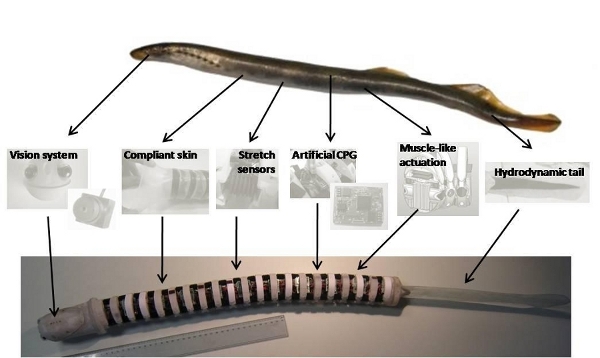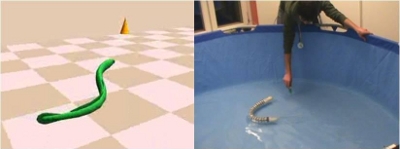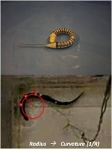An extremely bio-inspired artefact
During the LAMPETRA Project, thanks to the joint effort of roboticists, neurobiologists and computer scientists, an extremely bio-inspired artefact, based on animal models performing undulatory (eel-like) swimming, has been developed: it is composed by a high number of segments, a compliant body structure, muscle-like actuators, artificial stretch receptors, binocular vision system, low and high level control (mimicking the neuronal level, the biomechanical structure and the control functions of real lampreys/salamanders). Onboard components enable central pattern generation for replicating natural body movements and allow the use of sensor inputs for visuo-motor coordination and posture control


Figure 1: Scheme of control hardware architecture and onboard components
To date (February 2011), tests on goal-driven locomotion, selection of behavior and validation of neuroscientific theories are ongoing, paving the way to bio-hybrid experiments (figure 2).
In fact, in order to have a truly bioinspired artefact that can be driven by biological command signals, it is of fundamental importance that it replicates not only biomechanical aspects, but also control and behavioral functions.



Figure 1: Figure 2: Experiments and comparisons on object tracking, forward swimming and flexibility
Concerning the scientific impact of the Project, a substantial number of high impact publications are appearing. Partners have presented LAMPETRA results to many scientific events such as FET ’09 (4th best exhibit), ICRA 2009, ROBIO 2009 and the ICT4EE Exhibition.
Participation/sponsorship of other event are planned (FET 11, Bio-Inspired Robot Workshop 2011 in Nantes, IROS 11, AMAM 2011, ICRA 11).
Moreover, in collaboration with the Octopus Project, a Summer School will be organized in order to disclose LAMPETRA results. Finally, SSSA has been contacted by large European companies (LEGO, Magneti Marelli, Siemens) that for the exploitation of its patent on muscle-like actuation.



 About
About 





